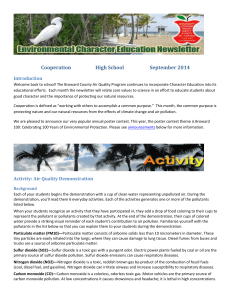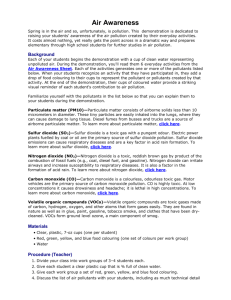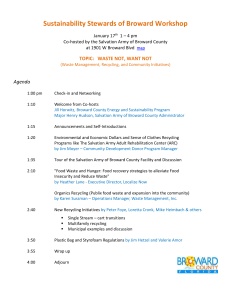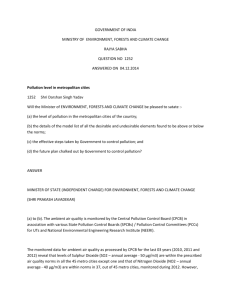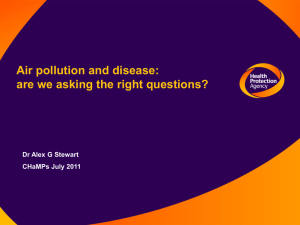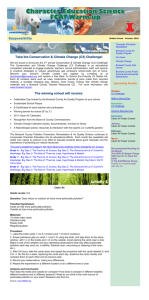Character Newsletter for Middle School Students
advertisement
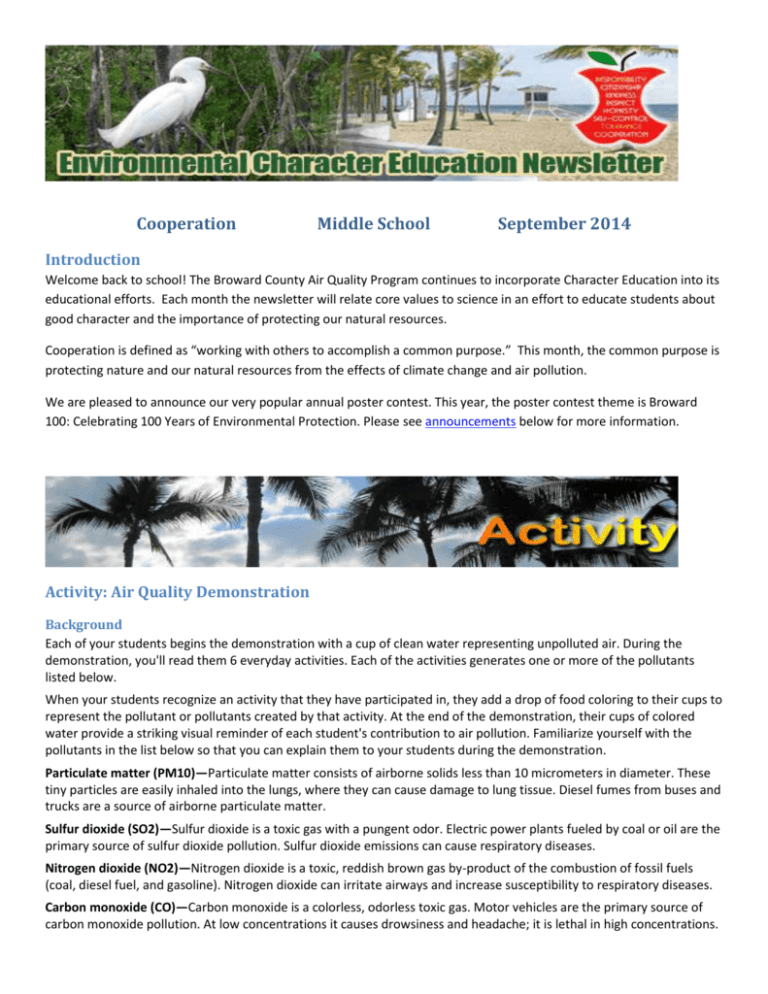
Cooperation Middle School September 2014 Introduction Welcome back to school! The Broward County Air Quality Program continues to incorporate Character Education into its educational efforts. Each month the newsletter will relate core values to science in an effort to educate students about good character and the importance of protecting our natural resources. Cooperation is defined as “working with others to accomplish a common purpose.” This month, the common purpose is protecting nature and our natural resources from the effects of climate change and air pollution. We are pleased to announce our very popular annual poster contest. This year, the poster contest theme is Broward 100: Celebrating 100 Years of Environmental Protection. Please see announcements below for more information. Activity: Air Quality Demonstration Background Each of your students begins the demonstration with a cup of clean water representing unpolluted air. During the demonstration, you'll read them 6 everyday activities. Each of the activities generates one or more of the pollutants listed below. When your students recognize an activity that they have participated in, they add a drop of food coloring to their cups to represent the pollutant or pollutants created by that activity. At the end of the demonstration, their cups of colored water provide a striking visual reminder of each student's contribution to air pollution. Familiarize yourself with the pollutants in the list below so that you can explain them to your students during the demonstration. Particulate matter (PM10)—Particulate matter consists of airborne solids less than 10 micrometers in diameter. These tiny particles are easily inhaled into the lungs, where they can cause damage to lung tissue. Diesel fumes from buses and trucks are a source of airborne particulate matter. Sulfur dioxide (SO2)—Sulfur dioxide is a toxic gas with a pungent odor. Electric power plants fueled by coal or oil are the primary source of sulfur dioxide pollution. Sulfur dioxide emissions can cause respiratory diseases. Nitrogen dioxide (NO2)—Nitrogen dioxide is a toxic, reddish brown gas by-product of the combustion of fossil fuels (coal, diesel fuel, and gasoline). Nitrogen dioxide can irritate airways and increase susceptibility to respiratory diseases. Carbon monoxide (CO)—Carbon monoxide is a colorless, odorless toxic gas. Motor vehicles are the primary source of carbon monoxide pollution. At low concentrations it causes drowsiness and headache; it is lethal in high concentrations. Volatile organic compounds (VOCs)—Volatile organic compounds are toxic gases made of carbon, hydrogen, oxygen, and other atoms that form gases easily. They are found in nature as well as in glue, paint, gasoline, tobacco smoke, and clothes that have been dry-cleaned. VOCs form ground level ozone, a main component of smog. The Activity We are often unaware of how our everyday activities contribute to air pollution. The purpose of this demonstration is to make you aware of the air pollution you create every day. The cup of clean water in front of you represents unpolluted air. You'll add drops of food coloring to the cup to represent the different types of air pollutants caused by the everyday activities that I'll describe to you. We'll use the following colors to represent these pollutants: Color Key Blue—pollutants from consumer products and paints (VOCs) Green—pollutants from lawn, garden, and construction machinery (CO, NO2, PM10, SO2, and VOCs) Red—pollutants from cars and trucks (CO, NO2, PM10, SO2, and VOCs) Yellow—pollutants from power plants and industrial processes (CO, NO2, PM10, SO2, and VOCs) Ask students to listen carefully while you describe the following activities. If students participated in the activity during the past 24 hours, have them add one drop of the appropriate color of food coloring to their cup of water. Some activities may not apply to them (for example, applying nail polish or mowing the lawn). Each student has their own cup, because each individual's contribution to air pollution is unique. 1. You showered and got ready for school. Add one drop of blue and one drop of yellow food coloring to your cup if this activity applies to you. Blue: VOCs emitted by soap, shampoo, deodorant, hair spray, perfume, and fingernail polish. Yellow: CO, NO2, PM10, and SO2 emitted by combustion used to heat the water for the shower. 2. You put on your favorite shirt, which your mom had dry-cleaned for you. Add one drop of yellow food coloring to your cup if this activity applies to you. Yellow: VOCs emitted by the dry-cleaning process. 3. Coming to school, you took the bus or rode in a car. Add one drop of red to your cup if this activity applies to you. Red: CO, NO2, PM10, SO2, and VOCs emitted by the engine in your school bus or car. 4. At lunchtime, you bought lunch in the cafeteria. Add one drop of yellow to your cup if this activity applies to you. Yellow: CO, NO2, PM10, SO2, and VOCs emitted by cooking lunch, Styrofoam trays, and plastic utensils. 5. Going home, you took the bus or rode in a car. Add one drop of red to your cup if this activity applies to you. Red: CO, NO2, PM10, SO2, and VOCs emitted by the engine in your school bus or car. 6. You mowed the lawn with a gasoline-powered lawnmower. Add one drop of green to your cup if this activity applies to you. Green: CO, NO2, PM10, SO2, and VOCs emitted by your lawnmower's engine. Discussion Ask your students the following questions: Look inside your cups. If the air pollution around you were this apparent, would you want to breathe the air? What other sources of air pollution, beyond those mentioned in this demonstration, could you think of as being produced in a single day? What could you do to reduce the number of pollutants released each day? If you have a container large enough, ask your students to pour their water into it, and then ask them to comment on the combined effect of each individual's pollution. Resource: Carolina World Class Support for Science and Math Announcements POSTER CONTEST ANNOUNCEMENT! Theme: Broward 100: Celebrating 100 Years of Environmental Protection For this poster contest, students should design a poster (winners will be featured in the 2016 calendar) showcasing environmental protection in Broward County through the past 100 years. Examples can include saving our air quality, trees and mangroves, animals (panthers, sea turtles, coral reefs), beaches, recycling and also highlight how climate change issues have grown in the past 100 years. On the back of the poster the students should describe their environmental protection concept and what changes have taken place over the past 100 years, especially here in Broward County. For complete contest rule and more information, please visit the Kids Club Contests page. Spread the Word! Subscribe to our FREE electronic Environmental Character Education Newsletters Today! The monthly edition of this newsletter is distributed only through a FREE electronic e-mail subscriber list. E-mail the Broward County Air Quality program at airoutreach@broward.org to receive this valuable curriculum resource. The newsletters are also available on our Environmental Kids Club web site at www.broward.org/kids. Broward Air Quality Index School Flag Program The Broward Air Quality Index (AQI) School Flag Program helps children, parents, the community and school personnel become aware of daily outdoor air quality conditions using brightly colored flags. Each day, a flag is raised in front of participating schools that signals the level of air pollution for that day and will be followed up with a mention during the school’s morning announcements. The flag colors correspond to the colors used in the Environmental Protection Agency’s (EPA) Air Quality Index, which tells how clean or polluted the air is for that day. When members of the school and the surrounding community know what the daily air quality is, they can adjust their activities to reduce their exposure to air pollution. Visit our website for more information on the Broward AQI School Flag Program. Important Links Environmental Character Education Newsletters Broward County Air Quality Program Broward County Environmental Kids Club NatureScape Broward STEM and Instructional Resources, Broward County Public Schools Broward County Public Schools Environmental Stewardship Facebook: Broward Environment YouTube: Broward Environment This year’s newsletters support the Next Generation Sunshine State Standards for Science Grade 6 – Big Idea 1: The Practice of Science; Big Idea 2: The Characteristics of Scientific Knowledge; Big Idea 3: The Role of Theories, Laws, Hypotheses & Models Grade 7 – Big Idea 1: The Practice of Science; Big Idea 2: The Characteristics of Scientific Knowledge; Big Idea 3: The Role of Theories, Laws, Hypotheses & Models; Big Idea 6: Earth Structures Grade 8 - Big Idea 1: The Practice of Science; Big Idea 2: The Characteristics of Scientific Knowledge; Big Idea 3: The Role of Theories, Laws, Hypotheses & Models Common Core State Standards for Literacy & Mathematics embedded throughout.
